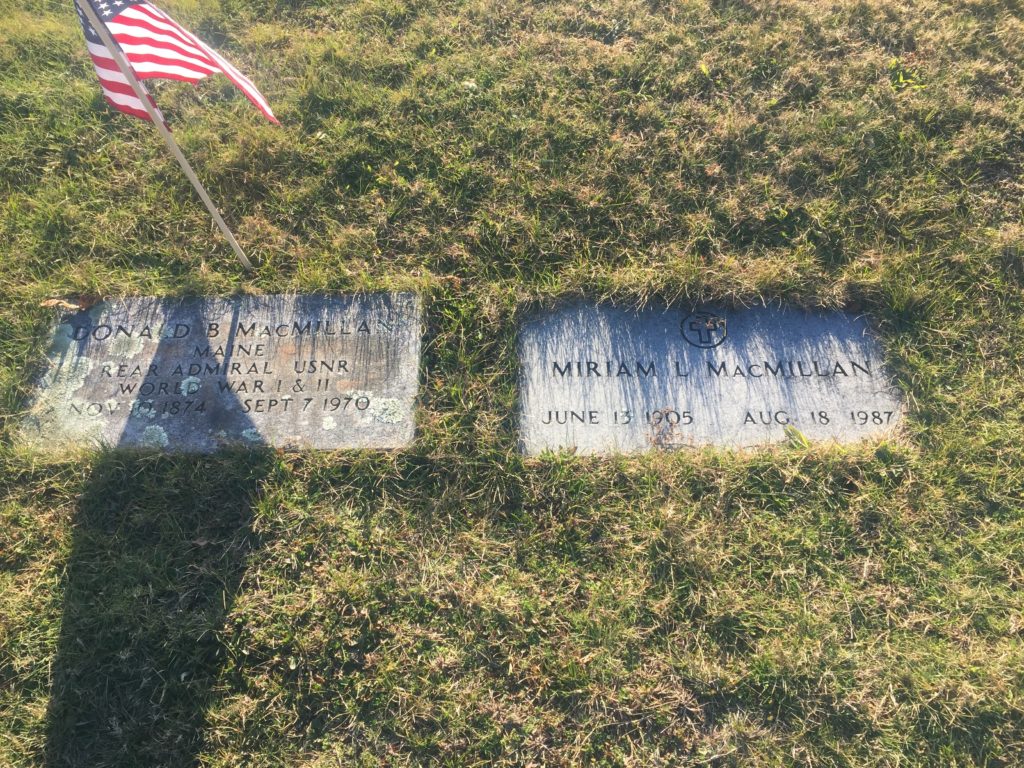Erik Visits an American Grave, Part 612
This is the grave of Donald and Miriam MacMillan.

Born in 1874 in Provincetown, Massachusetts, MacMillan was orphaned at the age of 12 after his sea captain father died at sea and his mother died of unknown causes. He moved to live with family in Freeport, Maine and then went to Bowdoin College, where he graduated with a geology degree in 1898. He taught at Worcester Academy between 1903 and 1908. After working for five years as a teacher, he engaged in a pretty radical career change. After he was involved in saving people from a shipwreck, the polar explorer and fellow Bowdoin alum Robert Peary invited him on an expedition to the North Pole. Naturally, this would change anyone’s life.
MacMillan did not actually make it all the way to the North Pole that Peary reached in 1909. He had to turn back pretty close to the goal after his heels froze, which seems understandable. But spent the next several years traveling around the northern regions of the planet, engaging in ethnological studies of the Inuit and Innu in Labrador. He organized the Crocker Land Expedition to northern Greenland in 1913. This was something that Peary had claimed to spot from his ship in 1906 but it seems to be a mirage, for it did not exist. Others have claimed that Peary simply made it up to get the San Francisco financier George Crocker to cough up more money for his expeditions by naming it after him. Anyway, the American Museum of Natural History, the American Geographic Society, and the University of Illinois Museum of Natural History sponsored it and with that, there was real money behind it. Alas, the whole thing was pretty much a disaster. The group did climb a giant glacier, but frostbite and desperation took a huge toll and soon there was only MacMillan, one of his fellow explorers, and two Inuit workers left on the exploration across the ice. Things did not get better from there. MacMillan and one guide set off after an illusion and it took the guide five days to convince the explorer that it was an illusion. That was better than the other half of the party, as the white explorer, the Naval engineer Fitzhugh Green, shot and murdered his own guide when they disagreed about which direction to go. Yikes. But then the whole history of global exploration was always tied up with colonialism, imperialism, and global white supremacy. In the end, the expedition did find a lot of interesting things in its four years, before the last men, including MacMillan, finally returned in 1917, but there was no Crocker Land. The next year, MacMillan wrote Four Years in the White North to celebrate the findings.
After World War I, MacMillan began raising money for another Arctic expedition. He spent 1921 exploring Baffin Island and, notably, using the new technology of radio to keep in contact with the outside world. In 1923, with concerns about a new ice age developing, the National Geographic Society sent him north for another Arctic expedition. In 1925, he led another expedition with Richard Byrd that used airplanes for polar exploration for the first time, though it was mostly unsuccessful because of the poor weather conditions for flying. The next year, he was back in Labrador on a mission that actually included three women to collect scientific and historical data on the area, including flora, fauna, and archeological surveys.
In 1935, MacMillan married Miriam Look, a woman nearly 30 years younger than he. Born in 1905 to an engineer father and classical musician mother, Look’s actual hero growing up was MacMillan and she used to pretend to be him when playing with her siblings. She went to Bowdoin as well and MacMillan became friends with her parents through that network. She worked as a fundraiser for a public relations firm until 1935, when she married her childhood hero. Now, Donald was not very interested in having Miriam along with him, thinking it was too dangerous, but she insisted and in 1938, she began accompanying him to the Arctic. She organized the trips and also ran a school he had started in 1929. She participated in nine trips to the Arctic and became the first woman to steer a ship through the polar ice. She also was a folklorist and anthropologist and recorded Inuit songs and made movies documenting both the Inuit and life on board a ship. By all accounts an outstanding public speaker, she did a lot to publicize what these explorations accomplished.
Donald volunteered in the Navy in World War II, even though he was 64 years ago. He transferred his ship to the Navy and was even given the title of Commander in 1942, while working in the Hydrographic Office in Washington. He continued exploring the Arctic after the war. He made his final trip to the North in 1957, when he was 82 years old. But he had a long time to go, living in retirement until 1970, when he died at the age of 95.
After Donald’s death, Miriam MacMillan continued working, mostly in organizing and cataloging their vast material from their expeditions. She was the honorary curator of the Peary-MacMilllan Arctic Museum and raised money for the restoration of their ship, also named the Bowdoin, in the 1980s. Her alma mater gave her an honorary degree in 1980 and she died in 1987.
Donald and Miriam MacMillan are buried in Provincetown Cemetery, Provincetown, Massachusetts.
If you would like this series to visit other polar explorers, you can donate to cover the required expenses here. Robert Peary is in Arlington, as are Finn and Jackie Ronne. Previous posts in this series are archived here.


